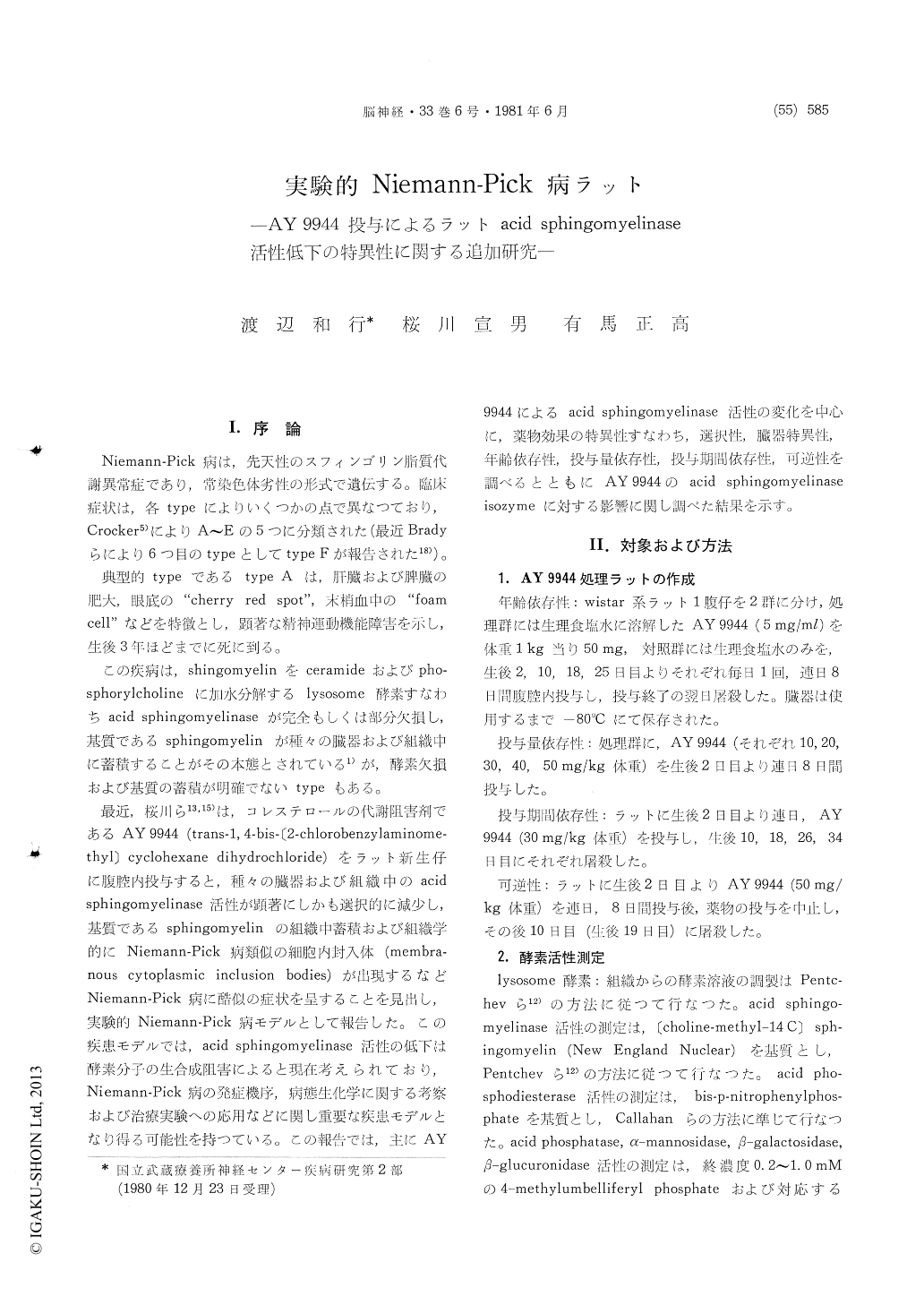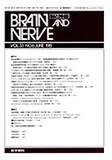Japanese
English
- 有料閲覧
- Abstract 文献概要
- 1ページ目 Look Inside
I.序論
Niemann-Pick病は,先天性のスフィンゴリン脂質代謝異常症であり,常染色体劣性の形式で遺伝する。臨床症状は,各typeによりいくつかの点で異なつており,Crocker5)によりA〜Eの5つに分類された(最近Bradyらにより6つ目のtypeとしてtype Fが報告された18))。
典型的typeであるtype Aは,肝臓および脾臓の肥大,眼底の"cherry red spot",末梢血中の"foamcell"などを特徴とし,顕著な精神運動機能障害を示し,生後3年ほどまでに死に到る。
Niemann-Pick disease, an inherited neurological disorders, is characterized biochemically by the deficiency of lysosomal acid sphingomyelinase which catalyzes the hydrolysis of sphingomyelin to cera-mide and phosphorylcholine.
Sakuragawa et al.14) described previously the spe-cific reduction of acid sphingomyelinase activities in various tissues and organs of suckling rats which recieved intraperitoneal injection of a hypocholes-terolemic agent, AY 9944 (trans-1, 4-bis [2-chloro-benzylaminomethyl] cyclohexane dihydrochloride).
We report this time, the results of more detailed studies about the specificity of the sphingomye-linase reduction caused by AY 9944.
Acid sphingomyelinase activity in the brain was decreased to about 50% of control values in rats which recieved AY 9944 (50mg/kg body weight/day) intraperitoneally daily for eight days, starting from day 2 of age, while acid phosphatase, acid phosphodiesterase, β-galactosidase, β-glucuronidase and α-mannosidase activities were normal or slight-ly increased (up to 124% of control values).
Mg-dependent neutral sphingomyelinase activity was slightly decreased, which might be, in part, due to the result of the reduction of acid sphingo-myelinase. Acid sphingomyelinase reduction was more pronounced in the liver (about to 15% of controls). Other five acid hydrolase activities were normal or slightly decreased.
Reduction of acid sphingomyelinase activity be-came mild in all organs of rats, treated with AY 9944 for eight days from 18th day after birth. Especially, brain acid sphingomyelinase in the ex-perimental rats was not affected at all, compared to that of controls.
Maximal changes of brain β-glucuronidase and α-mannosidase were observed in the rats treated for eight days from 10th day after birth.
In the long term treatment of AY 9944 (30mg/kg body weight) starting from 2nd day after birth, acid sphingomyelinase activity remained reduced in the liver, kidney and spleen up to 34 days after birth, but brain acid sphingomyelinase activity (reduced to about 70% of control valuses in the 10th and the 18th day after birth) returned to the normal level on the normal level on the 26th day after birth even during the continuos administra-tion of the drug.
Brain α-mannosidase and β-glucuronidase activi-ties increased significantly from the 10th day after birth.
These results suggested that there might be some regulatory systems or other factors of sphingo-myelinase biosynthesis, supposedly age-dependent.
Sphingomyelinase activities in brain and spleen were slightly increased in rats treated with rela-tively low AY 9944 dose (10mg/kg body weight), but were decreased with higher dose (30mg/kg body weight or more).
The reversibility of reduced acid sphingomyeli-nase was observed in the various organs, except for kidney, of rats 10 days after cessation of daily intraperitoneal injection of AY 9944 (50mg/kg body weight/day) for eight days begining at 2nd day after birth.
There were several peaks demonstrated by iso-electric focusing of acid sphingomyelinase of liver and brain from control 10-day-old rats. The pI values of the main peak of liver and brain were about 4.9 and about 6, respectively. No diffinite differences in the pattern of isoelectric focusing were found between experimental rats, which re-cieved AY 9944 (50mg/kg body weight/day) for eight days from 2nd day after birth, and control rats, but acid sphingomyelinase activity were gener-ally reduced in organs fram treated rats.
These results suggested that the reduction ofacid sphingomyelinase caused by AY 9944 admini-stration was quantitative, and did not contain any qualitative changes.

Copyright © 1981, Igaku-Shoin Ltd. All rights reserved.


